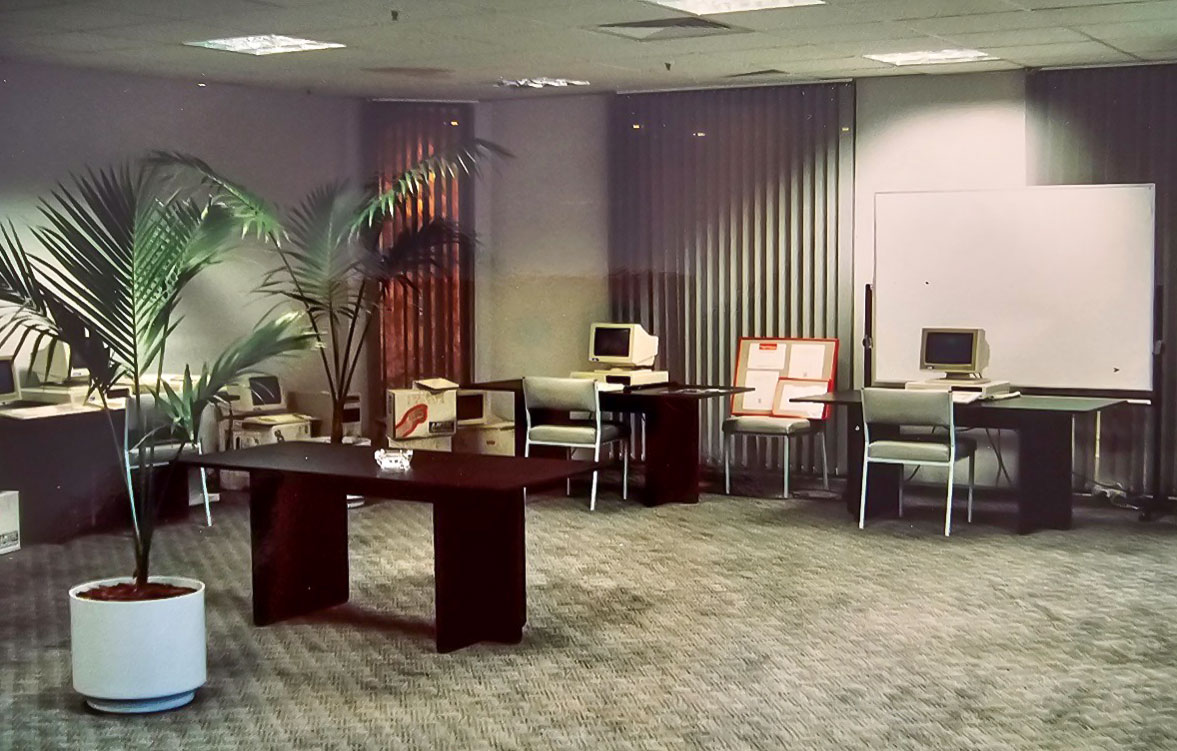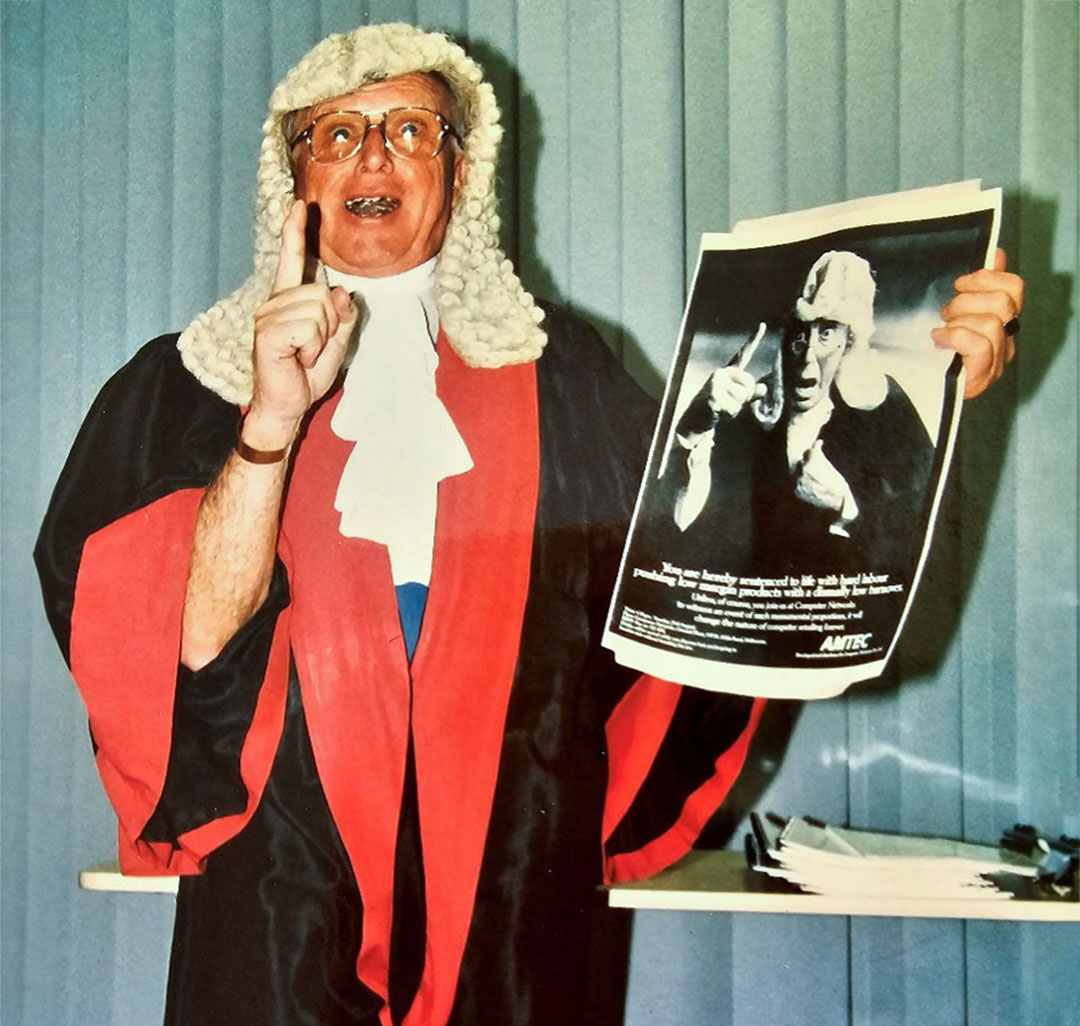
My employment as a salesperson for ORAD computers lasted only ten months but it was an excellent introduction to working and surviving in an urban environment, and I wasn’t unhappy that fate had tipped me into computer sales.
I’d learned that in the pre-sale cycle, success depends on your honesty and on spending most of your time listening to your customer and virtually no time waxing lyrical about your solution. l also learned that technical staff have a particularly jaundiced view of salespeople who promise the world, but if you win them over, everyone benefits.
The PC Revolution – A Brief History
Warning: This is really boring. If you abhor computer jargon, please skip this paragraph.
Up until the late seventies the vast majority of computer workstations were dumb terminals remotely attached to powerful mainframes, or to smaller but horrendously expensive, minicomputers. The Personal PC revolution was in its infancy when I came to Australia and we were taught that personal computers utilising the new Z80 intelligent processors and CP/M operating systems (Control Program Monitor), were the key to the future, and a cost-effective way of replacing dumb terminals.
The PCs we sold were NEC APC, Apricot, Sperry and Olivetti, and the networks were HINet, Token Ring, and eventually an early version of Novel. By the mid-eighties the IBM XT. 8 bit PC, was unveiled. These could be configured with one or two floppy drives, a 10 MB hard drive and 64k of RAM. As the market matured it evolved into a three-horse race between IBM, Compaq, and Apple.
IBM PCs contained the new Intel 8080 processor, and CP/M was abandoned in favour of Microsoft’s MS DOS (Microsoft Operating system) licensed as PC DOS by IBM. Apple, in its inimitable fashion, followed its own destiny with their Motorola processors and MAC OS operating system.
Intelligence
ORAD was struggling and In August 1984 the company succumbed to the inevitable, and the network department was sold to Intelligence Australia. Most of us kept our jobs with the new company, and we were pleased Intelligence had a more up to date outlook, and a more sophisticated range of multi-user software solutions to sell.
In this period some of the mid-range computer companies had experienced meteoric rises – and falls. Down at the personal computer level though, the marketplace was dynamic, with startups and insolvencies commonplace.
For my part, I now found myself selling a 4GL (4th Generation Language) solution called CBA, together with another package called ILAS (Intelligence Legal Accounting Software). My company, KGM Management, now acted in a sales agency capacity and to keep me in front of the prospects Intelligence employed Lee’s sister, Beverly, to handle my general secretarial duties, and I employed Donna Carter, who was more computer literate than me, and an excellent demonstrator.
The three of us were a great team, and in one eight-month period we sold ILAS, together with associated networks, to ten Melbourne legal firms.
Life was good until one morning on 18th January 1988, I received an early morning phone call advising me that Intelligence was about to go into voluntary administration. This company had treated me incredibly well and the news was a blow. My second Job had lasted 3 ½ years, a big improvement on my 10 months with ORAD, but disappointing, nevertheless.
Computer Networks
A week or two later with perfect timing for me, an advertisement appeared in the Melbourne Age seeking a General Manager to set up and run the Melbourne branch of a Sydney startup company called Computer Networks. I couldn’t believe my luck; this would be the perfect job if I could snare it. I forwarded my resume, together with a letter explaining the circumstances of my departure from Intelligence, I added the sweetener that I could possibly bring three key staff with me due to the collapse of Intelligence.
On 26th of February I received a formal offer for the advertised position at a starting salary of $60,000, (not too bad at that time) plus entertainment and car allowances. Computer Networks had also agreed to my request to attend their board meetings to represent the Melbourne Branch. Sadly though, there never were any board meetings to attend, and this should have alerted me to the looming crisis.
My initial responsibility was to submit a high level business plan supported by budgets, to locate appropriate premisses, and to employ the three ex-Intelligence people. They were Beverly, Steve Tickell in the network sales role, and Ian Hadley as the network implementation and support specialist.
My first task was to locate premises. It didn’t take long to send a portfolio of options to the MD in Sydney, and the instruction came back to negotiate the rental for the most prestigious one. This was situated in the atrium of a new high rise building in St Kilda Road. My previous employment since landing in Australia had been with two small, cash strapped companies. For my new employer however, money appeared to be no object.

The Computer Networks demonstration area, 1988.
The MD of Computer Networks was a brilliant young New Zealander who had received financial backing from his family, to set up a hi tech sales and distribution business in Australia. His imagination, energy, and marketing skills knew no bounds and in a remarkably short time, he’d set up a manufacturing facility to assemble PC clones from imported components. He’d created attractive marketing material, and by the time we’d fixed the signage on our new premisses, boxes of workstations and networking equipment were arriving. Now it was time to start selling.
Our job was to target major account clients. I decided to run a seminar to launch the arrival of our new company in Melbourne. The agenda would be to highlight our technology and the benefits we were able to offer to public accounting firms and legal practices. The marketing campaign would revolve around a fictional judge, warning of the folly of not attending.
We printed off a large number of brochures, and Lee’s father accepted my offer to pay him generously if he would dress up in a gown and wig and deliver the brochures to the reception desks of selected large firms in the Melbourne CBD.

Judge Robbie
He was up for the challenge and co-opted one of his mates from the golf club to be his driver and assist in the delivery process. The two men must have created quite a stir as they did their rounds in the top end of town because the campaign certainly worked and we were forced to rent larger premises for the seminar. When the event was over and the champagne glasses cleared away, we had a healthy pile of business cards to follow up on, and our new enterprise was successfully launched.
The following months were rewarding for our small crew. We were meeting our sales targets, we enjoyed working together in our beautiful new premises, and in early July, the company flew us to Sydney to celebrate the end of the financial year. We were escorted around their offices, and the new computer assembly facility. We were wined and dined, regaled with congratulatory speeches, and the champagne and cocktails flowed well into the night.
Two months later it was time for a break and Lee and I took a short holiday at a remote beach in the Philippines. On the return journey, we buckled ourselves into our Qantas seats in preparation for take-off. The hostess offered me a Sydney Morning Herald and started chatting with Lee while I opened the paper. She must have been alarmed at the look on my face. “Are you alright sir?” she asked. I didn’t answer. I handed the paper to Lee and pointed at the double column advertisement in the classified section.
Computer Networks Pty. Ltd. Lane Cove Sydney. (IN LIQUIDATION). it read. The business and assets are being offered for sale. At the present time it is not known what funds will be available for unsecured creditors. Signed E. G. CHANT, LIQUIDATOR. Deloitte Haskins + Sells.
I had departed Australia as Melbourne General Manager of Computer Networks and was returning home ten days later as an out of work unsecured creditor. The company wasn’t even in receivership, the business was dead! Thankfully when we arrived home, I found that Beverly and her dad had removed my car from the company car park, together with KGM Management’s precious customer files.
Computer Networks was liquidated on 23rd September 1988. I’d been in Australia for 5 ½ years and by my standards had precious little to show for it.
Ken Fife – August 2023

really enjoy reading your blogs Ken and you’re leaving a great legacy for your future generations. I would love to have more knowledge of my ancestors lives. I have been editing Denis’ story but unfortunately he only got up to arriving in NZ in1960. So that leaves me to try and finish our story, which I told him I would do, when I can get myself motivated!
Gee ,what a transition! From an N.Z farmer to computer / marketing whiz. Another interesting chapter, I look forward to more.
Well that was far too short (though I did skim the technical stuff). The plane trip with the newspaper headline was the stuff of films. I am impressed with your quick mastery of all the tech stuff and expect to read in the next episode how you turned your misfortune into a triumph. I have to say I do prefer the farming world to the tech one but you manage to make it into a good story nevertheless.
I also am amazed at your transition from a farmer to an IT geek!!!You can turn your hand to anything, Ken.
So much bad luck with the 3 companies folding, but you are a very resilient man as will no doubt be revealed in the next chapter 🙂
Thanks Anne. It all worked out in the end 🙂
Another great read – looking forward to more !
Blimey what next Ken!!!! Very interesting .
Crikey Ken, you seem to be the kiss of death on these firms. Hope the next chapter shows a change of fortune.
Hi Alison, I must confess at the time I was beginning to think the same thing. This wasn’t helped by an accountant from one of the big firms voicing the same sentiment, only his comment wasn’t the tongue in cheek variety! You’ll be able to see if the trend continued in my next chapter.
Enjoyed the blog Ken. I remember the first computer I purchased back in 1987. It was an Olivetti 1OMB HD with 640 kb mem. I got it for approx $2000. My first floppy program was a game Flight simulator that i enjoyed playing on the green screen. My next game a few years after that was a game a simulation of the Stock Market where you would read news of companies performance and purchase/sell stocks and then press F7 to advance one week. I remember in one month of playing for the game I must have in one year many about $300,000 profit. Pity it was only a game 🙂
PS Did you keep the copy of the morning herald btw
Hi Ghassan, I sold a lot of Olivetti computers in my early days. they were very good at the time.